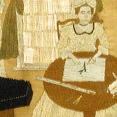Slavery: Documents & Activities
Connecticut State Library, Hartford, CT
This table shows the estimated enslaved black population in the colony of Connecticut between 1690
and 1774. The data are derived from the United States Bureau of the Census, Historical Statistics of
the United States, Colonial Times to 1957 (Washington, 1961).
Connecticut Slave Sale Advertisements
The documents on this page are typical of advertisements offering slaves for sale in Connecticut colony. One ad, “A Likely Negro Boy 11 Years Old,” is noteworthy for the name of the seller: Benedict Arnold of Norwich All images on this page are from America’s Historical Newspapers, an Archive of Americana collection, published by Readex, a division of NewsBank, in cooperation with the American Antiquarian Society.
Connecticut Runaway Sale Advertisements
Advertisements offering rewards for runaway slaves were a common feature in colonial Connecticut newspapers. All images on this page are from America’s Historical Newspapers, an Archive of Americana collection, published by Readex, a division of NewsBank, in cooperation with the American Antiquarian Society. Courtesy, America’s Historical Newspapers, an Archive of Americana collection, published by Readex, a division of NewsBank, in cooperation with the American Antiquarian Society
Danbury, CT 1765
James Montgomery Bailey, History of Danbury, Conn. 1684-1896 (Burr: New York, 1896), image facing p. 40.This deed documents the 1765 sale of a “Negro Boy Named Nimrod aged about four years” by Joseph Taylor of Danbury, Connecticut, to Lieutenant Noble Benedict of the same city, for a sum of twenty-five pounds. According to Bailey, Joseph Taylor was born in 1703.
Courtesy, Stamford
Probate Court Records, Stamford, CT
Transcription of the Will of Jeremiah Anderson (excerpt)
August 21, 1788 Stamford CT Probate Record, Book II 1790-1799
Silk Embroidery, by Prudence Punderson
Courtesy, The Connecticut Historical Society, Hartford, CT
Preston, CT ca. 1783
Prudence Punderson (1758-1784) was born in Preston, CT, the eldest of eight children. Her needlework, done before her marriage, is titled “The First, Second and Last Scenes of Mortality,” and represents three stages of life: infancy, womanhood, and death.
Activities
- Digging Deeper: To learn more about the lives of enslaved and free blacks in colonial Connecticut, read historian Peter Hinks’s article, “Enslaved Africans in the Colony of Connecticut” (download pdf).
- Thinking Like an Historian: Listen carefully to the video segment in the introduction to this module “Enslaved Africans in the Colony of Connecticut,” with Professor David Blight. What questions do historians ask about slavery? How does the study of slavery in New England change the way historians think about Connecticut’s past? Why is the study of local history important in understanding the past?
- Using Primary Documents: Advertisements from colonial newspapers giving notice of slave sales or runaways are a valuable source of information for historians. What sort of information can you discover about the daily lives of Connecticut slaves using the “Slave Sale Advertisements” and “Runaway Slave Advertisements” linked above? How did the individuals in the advertisements dress? What sort of work was required of them? For examples to get you started, see “Analyzing an Eighteenth-Century Runaway Slave Ad”(download pdf).







